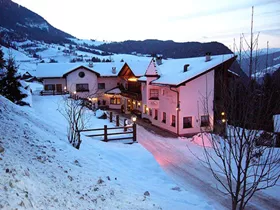
One of Austria's most popular ski areas, the Hintertux Glacier boasts 60km of slopes with the most reliable snow cover in the country. The Hintertux Glacier is also linked to the Zillertal 3000 ski area, which offers almost 200km of slopes at ski resorts like Mayrhofen and Finkenberg . But do you know what actually goes on inside a glacier? Here are five fascinating facts about the Hintertux Glacier.
The Hintertux Glacier is up to 1000 years old in some parts
In areas that regularly receive a lot of snow - such as on top of a high mountain - the snow accumulates. In years where the snow accumulates faster than it melts, the snow compacts into ice. This gradual accumulation of compacted ice eventually forms a glacier. Some of the ice at the very heart of the Hintertux Glacier is up to 1000 years old! Although glaciers retain this ice core in the summer, skiing conditions would be terrible without fresh snowfall on top.

The Hintertux Glacier is constantly moving
Due to their nature, glaciers are in a constant state of movement. Alpine glaciers tend to shift between 1 metre and 200 metres every year depending on a variety of factors including the glacier's size and the climate. The Hintertux Glacier has been known to move up to 60 metres some years, meaning the skiing facilities need to be repositioned up to 3 times a year! Glaciers also move faster or slower depending on the surface they're travelling on - for instance, around a corner, over a ridge, etc. These changes in speed provoke the formation of crevasses, which are usually around 30 metres deep.
The Hintertux Glacier is enormous
The Hintertux Glacier extends 4.1 kilometres between the Gefrorene Wand (3250m) to the Tuxer Fernerhaus (2660m). In total, the Hintertux glacier is made of around 190 million cubic metres of ice, which equates to about 171 billion litres of water. And you don't think about this when you're skiing on top of it, but the Hintertux glacier is actually up to 120 metres deep at its deepest points. This means you're skiing on top of a VERY thick layer of ice! So don't fall into one of the crevasses.

Climate change affects glaciers, but not in the way that you think
Strangely, air temperature is not the most important factor in the melting of glaciers. The biggest factor is the so-called darkening of glaciers due to cryconite, made of small rocks and other particles that accumulate on the surface of glaciers. While some amount of cryoconite is natural, human industrial activity, especially coal mining, has caused it to be darker and more prevalent. As everybody knows, white reflects light while black absorbs light and heat. When glaciers are darker, they heat faster. The small cryoconite rocks also sink from the surface of the glacier down into the ice, causing cylindrical melt holes. In an effort to combat the warmer temperatures of recent years, some ski areas in Europe are experimenting with snow farming to preserve snow over the summer months. This is a method whereby the snow is covered in insulating materials to reflect the heat from the sun and prevent it from melting.

The Hintertux Glacier is open for skiing 365 days a year
Austria actually has over 800 glaciers, 8 of which open for skiing. But the Hintertux Glacier is the only year-round glacier ski resort in Austria. Thanks to its reliable snow cover, the Hintertux Glacier is able to open for skiing and snowboarding 365 days a year, making it one of a handful of summer ski areas in Europe and a popular training ground for professional ski racers. Aside from skiing, visitors to the Hintertux Glacier can also visit an ice cave and go tobogganing.





